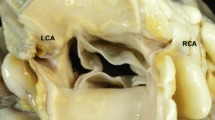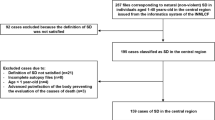Abstract
Backgrounds
Aortic rupture or dissection as immediate cause of sudden death is encountered in forensic and clinical autopsy practice. Despite a common denominator of ‘sudden aortic death’ (SAD), we expect that in both settings the diagnostic workup, being either primarily legal or primarily disease related, differs substantially, which may affect the eventual diagnoses.
Methods
We retrospectively reviewed case records of deceased persons who fitted a diagnosis of SAD in the continuous autopsy cohorts in a forensic (Suisse) and a clinical setting (The Netherlands). Clinical characteristics, data from post-mortem imaging, tissue blocks for histological analysis and results of ancillary studies were reviewed for its presence and outcome.
Results
SAD was found in 7.7% in the forensic versus 2.2% in the clinical autopsies. In the forensic setting, autopsy was always combined with post-mortem imaging, showing variable outcome on detection of aortic disruption and/or pericardial bleeding. Histology of aorta was performed in 12/35 cases, mostly in the natural deaths. In the clinical setting, histology of the aorta was available in all cases, but post-mortem imaging in none. In both settings, underlying aortic disease was mostly cystic medial degeneration, atherosclerosis or a combination of both, with occasional rare unexpected diagnosis. Also in both, a genetic cause of aortic dissection was revealed in a minority (three cases).
Conclusion
Sudden aortic death (SAD) is more commonly encountered in a forensic than in a clinical setting. Major differences in the approach of SAD between these settings coincide with similarities in causes of death and underlying diseases. To ensure a correct diagnosis, we recommend that the investigation of SAD includes a study of the medical history, a full autopsy with histology of major organs including aorta, and storage of material for toxicological and genetic testing. Post-mortem radiological examination, useful for documentation and screening purposes, is feasible as non-invasive alternative when autopsy is not possible, but cannot substitute a full autopsy.



Similar content being viewed by others
References
Halushka MK, Angelini A, Bartoloni G et al (2016) Consensus statement on surgical pathology of the aorta from the Society for Cardiovascular Pathology and the Association For European Cardiovascular Pathology: II. Noninflammatory degenerative diseases—nomenclature and diagnostic criteria. Cardiovasc Pathol 25:247–257. doi:10.1016/j.carpath.2016.03.002
Stone JR, Bruneval P, Angelini A et al (2015) Consensus statement on surgical pathology of the aorta from the Society for Cardiovascular Pathology and the Association for European Cardiovascular Pathology: I. Inflammatory diseases. Cardiovasc Pathol 24:267–278. doi:10.1016/j.carpath.2015.05.001
Virmani R, Burke AP, Farb A (2001) Sudden cardiac death. Cardiovasc Pathol 10:275–282. doi:10.1016/s1054-8807(01)00108-9
Ripperger T, Troger HD, Schmidtke J (2009) The genetic message of a sudden, unexpected death due to thoracic aortic dissection. Forensic Sci Int 187:1–5. doi:10.1016/j.forsciint.2009.01.020
Klintschar M, Bilkenroth U, Arslan-Kirchner M, Schmidtke J, Stiller D (2009) Marfan syndrome: clinical consequences resulting from a medicolegal autopsy of a case of sudden death due to aortic rupture. Int J Legal Med 123:55–58. doi:10.1007/s00414-008-0288-5
Hugar BS, Praveen S, Kainoor SK, Shetty ARS (2014) Sudden death in Marfan syndrome. J Forensic Sci 1126–8
Lindsay ME, Dietz HC (2011) Lessons on the pathogenesis of aneurysm from heritable conditions. Nature 473:308–316
Dean JH, Woznicki EM, O'Gara P et al (2014) Cocaine-related aortic dissection: lessons from the International Registry of Acute Aortic Dissection. Am J Med 127:878–885. doi:10.1016/j.amjmed.2014.05.005
Grabherr S, Doenz F, Steger B et al (2010) Multi-phase post-mortem CT angiography: development of a standardized protocol. Int J Leg Med: 1–12. doi:10.1007/s00414-010-0526-5
Brinkmann B (1999) Harmonisation of medico-legal autopsy rules. Int J Legal Med 113 (1):1–14. doi:10.1007/s004140050271
Basso C, Burke M, Fornes P et al (2008) Guidelines for autopsy investigation of sudden cardiac death. Virchows Arch 452:11–18. doi:10.1007/s00428-007-0505-5
Zerlauth JB, Doenz F, Dominguez A et al (2013) Surgical interventions with fatal outcome: utility of multi-phase postmortem CT angiography. Forensic Sci Int 225:32–41. doi:10.1016/j.forsciint.2012.05.013
Sieswerda-Hoogendoorn T, van Rijn RR (2010) Current techniques in postmortem imaging with specific attention to paediatric applications. Pediatr Radiol 40:141–152. quiz 259. doi:10.1007/s00247-009-1486-0
Krentz BV, Alamo L, Grimm J et al (2016) Performance of post-mortem CT compared to autopsy in children. Int J Legal Med 130:1089–1099. doi:10.1007/s00414-016-1370-z
Blokker BM, Wagensveld IM, Weustink AC, Oosterhuis JW, Hunink MGM (2016) Non-invasive or minimally invasive autopsy compared to conventional autopsy of suspected natural deaths in adults: a systematic review. Eur Radiol 26:1159–1179. doi:10.1007/s00330-015-3908-8
Kurra V, Lieber ML, Sola S et al (2010) Extent of thoracic aortic atheroma burden and long-term mortality after cardiothoracic surgery: a computed tomography study. JACC Cardiovascular Imaging 3:1020–1029. doi:10.1016/j.jcmg.2010.08.006
Xu L, Burke A (2013) Acute medial dissection of the ascending aorta: evolution of reactive histologic changes. Am J Surg Pathol 37:1275–1282. doi:10.1097/PAS.0b013e318294adc3
Lucena J, Blanco M, Jurado C et al (2010) Cocaine-related sudden death: a prospective investigation in south-west Spain. Eur Heart J 31:318–329. doi:10.1093/eurheartj/ehp557
Elefteriades JA, Pomianowski P (2013) Practical genetics of thoracic aortic aneurysm. Prog Cardiovasc Dis 56:57–67. doi:10.1016/j.pcad.2013.06.002
Albornoz G, Coady MA, Roberts M et al (2006) Familial thoracic aortic aneurysms and dissections—incidence, modes of inheritance, and phenotypic patterns. Ann Thorac Surg 82:1400–1405. doi:10.1016/j.athoracsur.2006.04.098
Lindsay ME, Dietz HC (2014) The genetic basis of aortic aneurysm. Cold Spring Harb Perspect Med. 4(9):a015909. doi:10.1101/cshperspect.a015909
Maleszewski JJ, Tazelaar HD, Horcher HM et al (2015) IgG4-related disease of the aortic valve: a report of two cases and review of the literature. Cardiovasc Pathol 24(1):56-59. doi:10.1016/j.carpath.2014.08.001
Hirani R, Koszyca B, Byard RW (2008) Marfan syndrome and sudden death within a family—aetiologic, molecular and diagnostic issues at autopsy. J Forensic Legal Med 15:205–209. doi:10.1016/j.jflm.2007.07.010
Savall F, Dedouit F, Piercecchi-Marti M-D, Leonetti G, Rougé D, Telmon N (2014) Acute aortic dissection diagnosed after embalming: macroscopic and microscopic findings. J Forensic Sci 59:1423–1426. doi:10.1111/1556-4029.12485
Halushka MK (2012) Single gene disorders of the aortic wall. Cardiovasc Pathol 21:240–244. doi:10.1016/j.carpath.2011.09.004
Bjorck M, Wanhainen A (2013) Pathophysiology of AAA: heredity vs environment. Prog Cardiovasc Dis 56:2–6. doi:10.1016/j.pcad.2013.05.003
Author information
Authors and Affiliations
Corresponding author
Rights and permissions
About this article
Cite this article
de Boer, H.H., Dedouit, F., Chappex, N. et al. Sudden aortic death—proposal for a comprehensive diagnostic approach in forensic and in clinical pathology practice. Int J Legal Med 131, 1565–1572 (2017). https://doi.org/10.1007/s00414-017-1560-3
Received:
Accepted:
Published:
Issue Date:
DOI: https://doi.org/10.1007/s00414-017-1560-3




